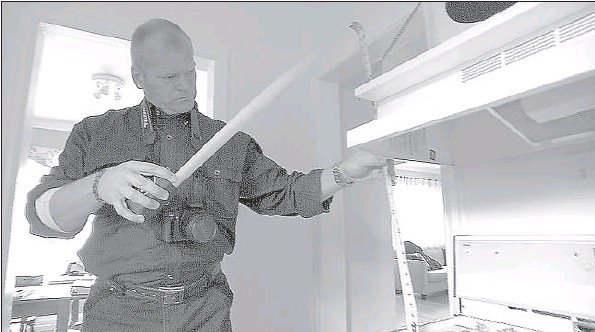VENTILATION: Make sure exhaust fan is right size for your kitchen
MIKE HOLMES
Province

The kitchen cooker fan needs to be close enough to the stove to efficiently extract air and moisture. — SUBMITTED PHOTO
Your stove — whether it’s gas or electric — needs to have an operating hood and extraction fan over it. These hoods aren’t just decorative — they are essential to help control excess moisture in your home, as well as to help remove cooking odours.
These ventilation systems have an exterior hood — the decorative part that hides the works — and an exhaust fan and ductwork to extract the air, smoke and moisture. Obviously, they need to be over the cooking area — and ideally they should extend out over the stove’s surface area. They need to be close enough to the stove to efficiently extract air, but not so close you can’t comfortably cook. If they are too high up, like many “designer” hoods, they aren’t doing a very effective job.
Your kitchen exhaust fan really needs to be discharged to the outdoors — that’s ideal. Never exhaust into the attic or soffits or crawl space. I’ve come across situations where the kitchen fans actually vent into the attic space; this is a really bad idea — for lots of reasons. First, the last thing you want to do is allow hot, moist air up into your attic space, especially in winter. It will lead to ice dams, mould, rot and a world of trouble caused by condensation.
Second, if you ever had a fire on the stove, the exhaust fan could pull the fire into the attic, and allow it to quickly spread through the house.
The ducting should be smooth, with a short, straight run to the outside, with as few bends and angles as possible. This will help with your fan’s efficiency in moving the air out. If the run is very long, you might need a bigger fan — check with a pro. The joints need to be sealed, and if the duct runs through an unheated space, they should be insulated. If they aren’t, condensation might form on the duct.
Kitchen exhaust fans come in different sizes — and need to be appropriate for the size of your stove and house. It’s very important that you get the correct size of ventilation fan for your kitchen. It’s not as simple as “bigger is better.”
Not only will your utility bills be higher than they need to be because you are running an oversized fan, you are also exhausting larger amounts of heated or cooled (depending on the season) air from your home. And that’s air you’ve paid to condition, which will affect the energy efficiency of your home. A fan that’s too large will create air infiltration and compromise the building envelope.
A much more serious problem, if you have installed an exhaust fan that’s too big, is that you can cause depressurization, which will lead to backdrafting. Backdrafting happens when exhaust fans pull the gases from combustion back into the house. These gases are the byproduct of fireplaces, hot water heaters, furnaces—any combustion appliance that is vented to the outside — and these gases are dangerous. They can kill you.
Most new homes are pretty airtight — that’s one of the reasons we have such few problems with indoor air quality and mould growth in new homes. Airtight homes have mechanical ventilation systems, like heat-recovery ventilators, to provide a fresh air supply. If you don’t have replacement air coming in, you’ll risk creating negative pressure (backdrafting), but also your fan will be starved for air and won’t even work properly to do the job you’ve installed it for.
If your HVAC system — including the kitchen exhaust fan — was designed and installed professionally, the ventilation will have been balanced. There will be the proper amount of air being extracted, relative to what’s being brought in or recirculated in the system. There needs to be dedicated makeup air to replace what the fan might pull out, or you risk depressurization and backdrafting.
If you have any doubt at all about this, get a qualified professional in to check your HVAC (Heating, Ventilation and Air Conditioning) system and the kitchen exhaust, and install a CO alarm in your home (which every home should have anyway).
You often will see recirculating kitchen exhaust fans that don’t expel air to the outside. They pull steam and smoke from the stovetop, filter it and recirculate it through vents at head level. These fans might remove odours, since they usually have a charcoal filter, but they don’t do anything for removing steam.
Don’t forget — boiling water and steaming vegetables creates a lot of moisture in the air that needs to be discharged.
These recirculating fans don’t cause depressurization, since they aren’t vented externally. To my mind, they don’t really remove much odour, or grease, and they blow into your face when you’re at the stove.
They also can be expensive when you need to replace the filters — and so people don’t do so as often as they should, which means they don’t work well at all. I really believe you need to have your kitchen fan exhaust outside.
Catch Mike in his brand new series, Holmes Inspection airing Thursdays at 8 p.m. ET/PT on HGTV. For more information visit www.hgtv.ca
